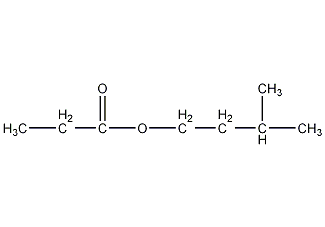
Structural formula
| Business number | 02S6 |
|---|---|
| Molecular formula | C8H16O2 |
| Molecular weight | 144.21 |
| label |
3-Methyl-1-butanol propionate, 3-Methyl-1-butylpropionic acid, 3-Methyl-1-butanol propionate, 3-Methyl-1-butyl propionate, Isoamyl propionate, non-reactive diluent, spices, Extracting agent |
Numbering system
CAS number:105-68-0
MDL number:MFCD00048611
EINECS number:203-322-1
RTECS number:NT0190000
BRN number:None
PubChem number:24900849
Physical property data
1. Properties: colorless and transparent liquid with apple aroma. [1]
2. Melting point (℃): -73[2]
3. Boiling point (℃): 156[3]
4. Relative density (water = 1): 0.871[4]
5. Relative vapor Density (air=1): 5.0[5]
6. Saturated vapor pressure (kPa): 0.27 (25℃)[6]
7. Heat of combustion (kJ/mol): -4840.0[7]
8. Octanol/water partition coefficient: 2.760[8 ]
9. Flash point (℃): 47.78 (CC) [9]
10. Solubility: slightly soluble in water , miscible in ethanol and ether, insoluble in glycerol and propylene glycol. [10]
11. Viscosity (mPa·s, 15ºC): 1.377
12. Heat of evaporation (KJ/mol): 37.97
13. Heat of formation (KJ/mol): 588.2
14. Specific heat capacity (KJ/(kg·K), 20ºC, constant pressure): 1.92
15. Volume expansion coefficient (K-1): 0.00108
16. Relative density (25℃, 4℃): 0.8650
17. Refractive index at room temperature ( n25): 1.4036
Toxicological data
1. Acute toxicity[11]
LD50: 4355mg/kg (rat oral); 6900mg/kg (rabbit oral ); 4355mg/kg (rabbit transdermal)
2. Irritation No data yet
Ecological data
1. Ecotoxicity No data available
2. Biodegradability No data available
3. Non-biodegradability No information available
4. Other harmful effects[12] This substance may be harmful to the environment, and special attention should be paid to water bodies.
Molecular structure data
1. Molar refractive index: 40.84
2. Molar volume (cm3/mol): 164.4
3. Isotonic specific volume (90.2K ): 372.5
4. Surface tension (dyne/cm): 26.3
5. Dielectric constant:
6. Dipole moment (10-24cm3):
7. Polarizability: 16.19
Compute chemical data
1. Reference value for hydrophobic parameter calculation (XlogP): None
2. Number of hydrogen bond donors: 0
3. Number of hydrogen bond acceptors: 2
4. Number of rotatable chemical bonds: 5
5. Number of tautomers: none
6. Topological molecule polar surface area 26.3
7. Number of heavy atoms: 10
8. Surface charge: 0
9. Complexity: 97.4
10. Number of isotope atoms: 0
11. Determine the number of atomic stereocenters: 0
12. Uncertain number of atomic stereocenters: 0
13. Determine the number of chemical bond stereocenters: 0
14. Number of uncertain chemical bond stereocenters: 0
15. Number of covalent bond units: 1
Properties and stability
1. Stability[13] Stable
2. Incompatible substances[14] Strong oxidizing agent
3. Polymerization hazard[15] No polymerization
Storage method
Storage Precautions[16] Stored in a cool, ventilated warehouse. Keep away from fire and heat sources. The storage temperature should not exceed 37℃. Keep container tightly sealed. should be kept away from oxidizer, do not store together. Use explosion-proof lighting and ventilation facilities. It is prohibited to use mechanical equipment and tools that are prone to sparks. The storage area should be equipped with emergency release equipment and suitable containment materials.
Synthesis method
It is produced by esterification reaction using propionic acid and isoamyl alcohol as raw materials and sulfuric acid as catalyst. Operation example: Mix 3 kg of propionic acid, 2.3 kg of isoamyl alcohol, and 250 g of sulfuric acid, then heat and reflux for 8 hours. After cooling, separate the lower layer of sulfuric acid liquid, first wash it twice with water, then wash it once with 10% sodium carbonate, and finally wash it with water again. The aqueous layer is separated and dried with 10% potassium carbonate, and the fraction at 159-162°C is collected by fractionation as the finished product.

Refining method: often contains free Impurities such as acids and alcohols and amyl propionate. During refining, wash with potassium bicarbonate solution, dry with anhydrous sodium sulfate or potassium carbonate and then rectify.
Purpose
1. Used to blend apple, pineapple, pear, strawberry and other spices, and also used for artificial flower essential oils. Used as cold food, bread and chewing gum flavoring.
2. Used as a solvent to dissolve nitrocellulose, nitrocellulose paint and resin.
3. Used as solvent and extraction agent. [17]


